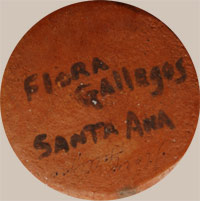Flora Gallegos
+ Add Artist to My Preferences

The original pueblo of Santa Ana was located close to Zia Pueblo and pottery from the two villages was quite similar in materials, technique and construction. In the mid-1700s, the pueblo acquired land near Bernalillo, just north of Albuquerque, for better farming land. This change in location effected a change in pottery as well. Santa Ana abandoned using lava as a tempering agent and started using river sand found close to the new village, which they had named Ranchitos. The old village is still maintained by a caretaker and is open for the annual feast day.
The move from the ancestral village to the new village of Ranchitos may be the reason for discontinuance of pottery production by those at Santa Ana. Sand temper was different from the basalt they were used to using and the quality of the pottery was more porous and less refined. It is probable that it was not as useable for day-to-day utilitarian use. It would be over 200 years before pottery production resumed again in any significant quantity.
Shortly after World War II a few potters from Santa Ana started selling pottery at Coronado State Monument near Albuquerque. Even this did not last long. By the mid-1970s, there was only one active potter at Santa Ana and she was Eudora Montoya. Montoya singly revived pottery production at the pueblo in the 1970s by teaching classes to a group of 18 women. This revival spurred interest in Santa Ana pottery; however that did not last long because most of the new potters did not continue production.
It is quite possible that Flora Gallegos was a student of Eudora Montoya or perhaps a student of the later revival of pottery production. One of Eudora Montoya's original students—Elvira S. Montoya—instituted another revival in 1994, a revival that is still surviving, but barely.

